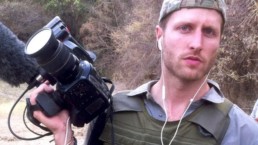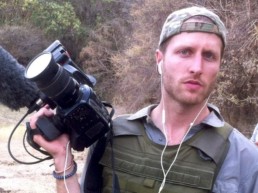Director Matthew Heineman on ‘Cartel Land’
"Shootouts in the streets of Michoacán, meth labs in the dark desert night, torture chambers... I never imagined I would get these things on film."
It’s hard to imagine anyone willingly subject themselves to live among some of the most dangerous and violent gangs in the world. Director Matthew Heineman says he had no choice– in order to accurately tell the story of the unfortunate but undeniable presence of drug cartels in Mexico, he had to be patient as he gained the trust of his subjects, whose stories are as somber as they are shocking. A Sundance favorite, Cartel Land is a riveting, on-the-ground look at two modern-day vigilante groups and their common interest in stopping the notorious Mexican cartels. We chat exclusively with Heineman days before the theatrical release of his film, talking about his initial interest in the subject matter, keeping cool in the midst of evil, and getting distribution in Mexico. We begin:
How did you develop your interest in the subject matter?
I read this Rolling Stone article on the subway in New York about the Arizona vigilantes. [At that time] I knew nothing about vigilantes, the border or the drug war and I was fascinated by it. I set out to gain access from Tim “Nailer” Foley who was leading this vigilante group on the Arizona side of the Mexican border and I spent a couple months filming with him. My father actually sent me an article from The Wall Street Journal about the Autodefensas. Right away I knew I wanted to create this parallel about vigilantes on both sides of the border fighting the same common enemy- the Mexican drug cartel. About two weeks later I was down in Mexico, but I had absolutely no idea the journey I would go on, the places I would find myself or the violence that I would witness. Shootouts in the streets of Michoacán, meth labs in the dark desert night, torture chambers… I never imagined I would get these things on film.
How did you prepare for what you were about to experience?
On my last film, Escape Fire: The Fight to Rescue American Healthcare, I think I spent about 8 or 9 months researching before I even picked up a camera. I wanted to make a very different film this time, I wanted to make a vérité film, from the third person, on-the-ground perspective. I wanted to get right in the middle of the action and see the effects that the cartel had on everyday people. So the process was much more [focused on] preparing to shoot in these conditions, like taking as many security precautions as we could.
What was going through your mind while making the film? How did you keep your cool?
It’s hard to say, a lot of it was instinctual. I think what kept me “cool” in situations was actually the craft of filmmaking– focusing on exposing, on framing. I guess it calmed me to some degree, but I can’t pretend I was really calm. I mean, anyone who has been in that situation knows it’s frightening and exhilarating. There were other moments that, to me, were even scarier, like the interview I did with the young woman whose husband was kidnapped by the cartel and chopped up to pieces in front of her. To hear her talk about the horror she witnessed and to be next to this woman who’s body was in front of me but who’s soul was out of her psychologically messed with me a lot, more than some of the adrenaline-filled moments.

How did you approach the subjects and gain their trust?
In time. A lot of people, especially in Mexico, were covering this story but they come in for a day or two and it’s really, really difficult to tell a complicated story in that amount of time. I had the luxury of being down there for almost a year, and forging really deep relationships with people.
Did you encounter people who didn’t want to be on camera?
Oh yeah, and that goes back to the blurriness of not knowing who’s the good guy and who’s the bad guy. The blurry lines between good and evil. At certain times, people didn’t want me to show certain things, but I felt like it was important to. I did what I needed to do to tell this story.
TIME MAGAZINE’S COVER PAGE ON FEBRUARY 24, 2014– the same day as the autodefensas anniversary- has the Mexican president with the caption “Saving Mexico”. What is your take on that?
There are alternative covers to that magazine cover in which people superimposed images of the doctor [Dr. Jose Mireles] instead of the President with the same caption ‘Saving Mexico.’ We take so many things for granted here: basic security and justice. In Mexico, that doesn’t exist. The judicial system and the police are all operating in collusion with the cartel. People on the ground have an extraordinary distrust of the government, and rightly so.

It’s been a little over a year since the film’s completion, have there been any updates that you’re aware of?
Right after we were done filming and submitting the film to Sundance, 43 students were killed in Guerrero, which is just South of Michoacán, and it provoked this national and international outcry. Although, situations like this had happened numerous times in recent history. This many people killed and the fact that they were students killed by the cartel working directly with the government really provoked an outcry. I don’t necessarily see and end to the cycle of violence. As long as there’s a demand for drugs in America, there will be a supply of drugs in Mexico.
Have the subjects been able to see the finished film?
‘Nailer’ saw the film, he came to Sundance for a few days as well. As you can imagine, on the other side of the border Dr. Jose Mireles has been unable to see the film.

How involved were you in the distribution process?
The film premiered at Sundance and I was lucky to get really good reception from that. It played in festivals through the spring and I’m really excited to have the film released theatrically both in the U.S. and Mexico. I’m excited to see it span beyond the film community audience to the general public.
H. Nelson Tracey
Nelson is a film director and editor from Denver based in Los Angeles. In addition to writing for Cinemacy, he has worked on multiple high profile documentaries and curates the YouTube channel "Hint of Film." You can check out more of his work at his website, hnelsontracey.com


